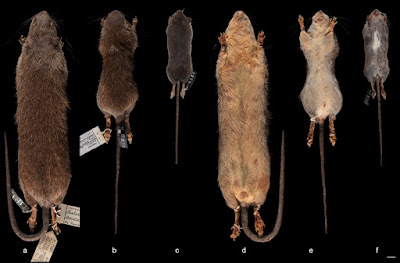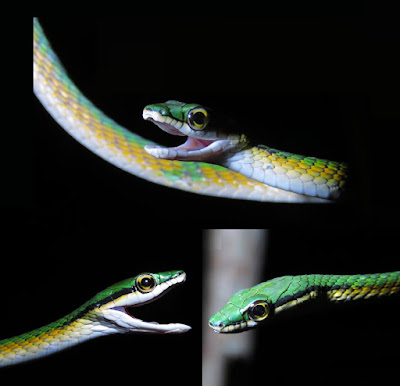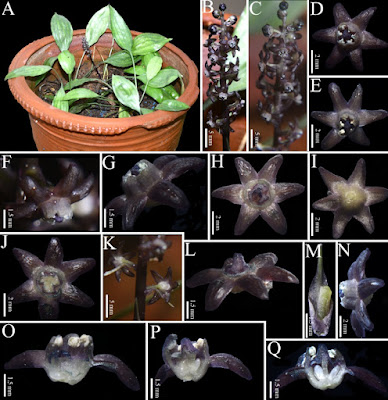 |
Rattus obiensis R. halmaheraensis Fabre, Miguez, Holden, Fitriana, Semiadi, Musser & Helgen, 2023
|
Abstract
Four new species of Rattus are described from the Moluccan islands (Maluku) of Indonesia: Rattus taliabuensis and R. feileri, both from the island of Taliabu, and R. halmaheraensis and R. obiensis from the islands of Halmahera and Obi, respectively. These descriptions are presented as part of a taxonomic review of Moluccan Rattus based on all known specimens in museum collections worldwide. Morphological characters, molecular systematics, and geographical distributions are documented for each of these species. Using both morpho-anatomical and morphometric approaches, we found that the Maluku Islands support Rattus taxa with spiny fur and two distinct morphotypes (1) species with a long tail and short rostrum (R. morotaiensis, R. halmaheraensis, R. obiensis, R. feileri) and (2) species with a short tail and long rostrum (R. taliabuensis, R. feliceus, R. ceramicus, R. elaphinus). Most of the new Moluccan species belong to a clade that includes members of the R. xanthurus species group from Sulawesi and the Australo-Papuan Rattus lineages. Their phylogenetic relationships highlight the role of Wallacea as an important area for diversification of Rattus into the Australo-Papuan region. Finally, the morphologically distinctive taxon Nesoromys ceramicus from Seram was found to be sister species to R. feliceus, and we relegate Nesoromys into the synonymy of the genus Rattus. The close affinities between R. ceramicus and R. feliceus may be an example of in situ island speciation, which has not been observed for small mammals on other Maluku Islands.
Keywords: biodiversity, biogeography, Maluku, molecular systematics, morphology, Murinae, Rattini, Wallacea
 |
Dorsal and ventral views of study skins of
(a, d) Rattus feileri sp. nov. (SNSD 11429 holotype);
(b, e) R. elaphinus (AMNH 109322 paratype); and
(c, f) R. taliabuensis sp. nov. (SNSD 11968 holotype).
Scale bar 10 mm. |
 |
Dorsal and ventral views of study skins of
(a, d) Rattus morotaiensis (AM M.7084);
(b, e) R. halmaheraensis sp. nov. (AM M.23652 holotype); and
(c, f) R. obiensis sp. nov. (MZB 38231, holotype).
Scale bars 10 mm. |
 |
External appearance (a) of the holotype of Rattus obiensis sp. nov. shortly after capture.
Both fore and hind feet are pictured (b–c and d–e, respectively). |
Pierre-Henri Fabre; Roberto Portela Miguez; Mary Ellen Holden; Yuli S. Fitriana; Gono Semiadi; Guy G. Musser and Kristofer M. Helgen. 2023. Review of Moluccan
Rattus (Rodentia: Muridae) with Description of Four New Species.
Records of the Australian Museum. 75(5): 673–718. DOI:
doi.org/10.3853/j.2201-4349.75.2023.1783 x.com/ArloHinckley/status/1735385182361026951
Abstrak [Bahasa Indonesia]. Empat spesies baru Rattus dideskripsi dari Kepulauan Maluku, yaitu Rattus taliabuensis dan R. feileri dari Pulau Taliabu, R. halmaheraensis dan R. obiensis masing-masing dari Pulau Halmahera dan Pulau Obi. Deskripsi spesies baru tersebut merupakan bagian dari reviu taksonomi Rattus dari Maluku berdasarkan semua spesimen yang ada di seluruh koleksi museum dunia. Selain spesies baru, juga didokumentasikan karakter morfologi, sistematika molekuler dan persebaran geografis Rattus dari Maluku. Dengan menggunakan pendekatan morfo-anatomi dan morfometri, kami menemukan bahwa Maluku memiliki taksa Rattus dengan rambut duri dan dua morfotipe yang berbeda yaitu (1) berekor panjang dan moncong pendek (R. morotaiensis, R. halmaheraensis, R. obiensis, R. feileri) atau (2) berekor pendek dan moncong panjang (R. taliabuensis, R. feliceus, R. ceramicus, R. elaphinus). Semua spesies baru dari Maluku termasuk dalam satu kelompok anggota R. xanthurus-group dari garis keturunan Rattus Sulawesi dan Australo-Papua. Hubungan kekerabatan mereka menunjukkan peran Wallacea sebagai jalur kolonisasi Rattus menuju ke kawasan Australo-Papua. Terakhir, Nesoromys ceramicus dari Seram yang secara morfologis berbeda, diketahui merupakan sister spesies dari R. feliceus. Oleh karena itu, kami mengusulkan agar genus Nesoromys ditempatkan di dalam genus Rattus. Kedekatan antara R. ceramicus dan R. feliceus kemungkinan merupakan contoh dari spesiasi pulau in situ, yang belum pernah diamati pada mamalia kecil di pulau-pulau lain di Maluku





































